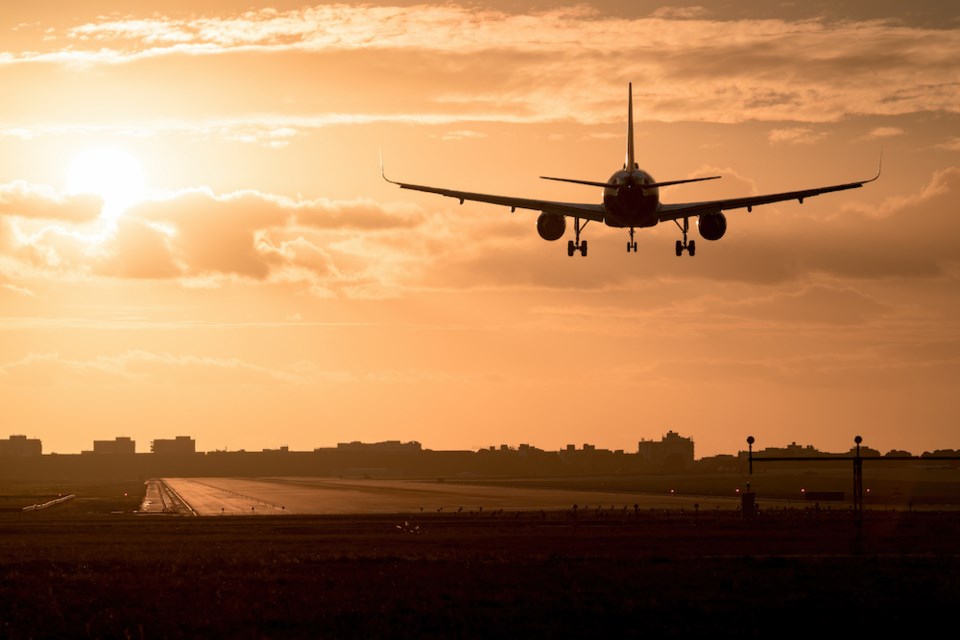Noise — how it's measured and what it sounds like when jets fly overhead — is among the concerns being raised about proposed changes to aircraft flight paths over Coquitlam, Port Coquitlam and Port Moody.
And a Coquitlam resident has started a petition to stop NAV CANADA's plans to alter flight paths over the Tri-Cities while Port Coquitlam Mayor Brad West is also jumping into the fray.
In a letter sent to NAV CANADA, West has called for a meeting with officials after residents started emailing him about safety and noise pollution.
The letter sent on Tuesday (Jan. 24) asks NAV CANADA to "shift" aircraft routes over "less populated areas," such as waterways, highways, and industrial and commercial areas.
"The residents of Port Coquitlam have been raising concerns about how additional flights over our city will impact the community with regards to noise pollution and safety risks," West's letter states.
PoCo's Mary Hill neighbourhood, along with Westwood Plateau in Coquitlam and Mountain Meadows in Port Moody, are among the areas affected, maps of the new routes show.
Shorten routes and reduce fuel
NAV CANADA, a not-for-profit corporation responsible for air traffic, is proposing to alter instrument approach procedures for Vancouver International Airport (YVR) to shorten routes and reduce fuel.
However, some residents worry that aircraft noise will become more frequent, with more planes flying overhead.
Kenneth Bell, a Westwood Plateau resident, who started the petition, hopes his efforts will lead to more awareness and stop NAV CANADA from putting more planes over his home.
"I want to raise awareness about the situation. I think people have no idea about planning in the works... I don’t know if we can stop NAV CANADA'S plans. [but] I don’t want to sit idly by."
Aircraft noise, especially in the evening, has been one of the major issues raised.
Noise modelling conducted by the agency suggest noise levels will be between 50 db and 60 db in some areas.
Noise modelling 'simplistic'
But while noise at 60 db is the equivalent of a conversation, some residents say it will be disturbing, particularly at night.
Aaron Norris, who attended an open house on the route changes, said the noise may be more noticeable in areas of higher elevation.
The Port Moody man, who lives in the Mountain Meadows neighbourhood, said the noise modelling is lacking in detail — and NAV CANADA hasn't been forthcoming about the impacts of changes.
"They’ve definitely got an agenda and a narrative."
On NAV CANADA's website, there are flight maps, noise modelling maps, dates for upcoming public information sessions, a survey, and reasons why the changes are being made.
However, Norris, who attended the Coquitlam meeting, said information provided by NAV CANADA didn't provide much detail about how changes will affect residents living under the new flight path.
"They really leaned on the noise modelling to explain and downplay noise pollution impacts on residents. This is despite the admitted limitations of their simplistic analysis."
For example, representatives said maximum noise levels of 60 db would be as loud as a normal conversation.
Norris said the explanation doesn't take into account how many aircraft will fly over his house in a 24-hour period nor how loud they will be.
Implementation may happen late fall
"In my opinion, this is another misrepresentation made without adequate qualification — the human voice sounds nothing like the screaming whine of a turbofan jet engine and other aerodynamic noise generated by aircraft — the wall of white noise would surely drown out normal conversations for however long it takes for the aircraft to pass by."
In response to a query from the Tri-City News, NAV CANADA acknowledged that aircraft noise would depend on the aircraft type, configuration, flight profile, atmospheric conditions and winds.
But noise from jet airplanes flying to YVR currently are typically at noise levels of between 50 and 55 db, a spokesperson stated, noting that a 737-800 was used to model aircraft noise.
Public consultation is ongoing until Feb. 3; then, it's expected to take two to three months for a decision, with a possible operational change by November/December 2023.
Still, that date could be postponed depending on outcomes of the feedback and changes required.
"If the consultation report recommends changes to the existing proposal, implementation would be moved further into the future (by how far would depend on the nature of the changes)," NAV CANADA explained in an email.


